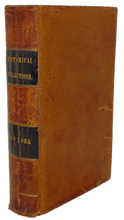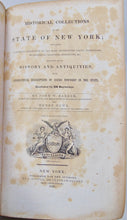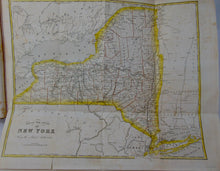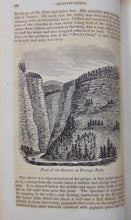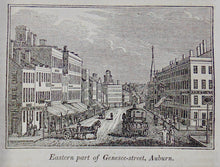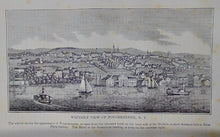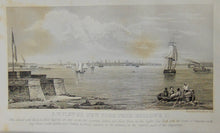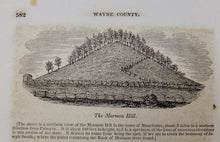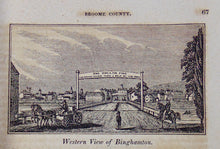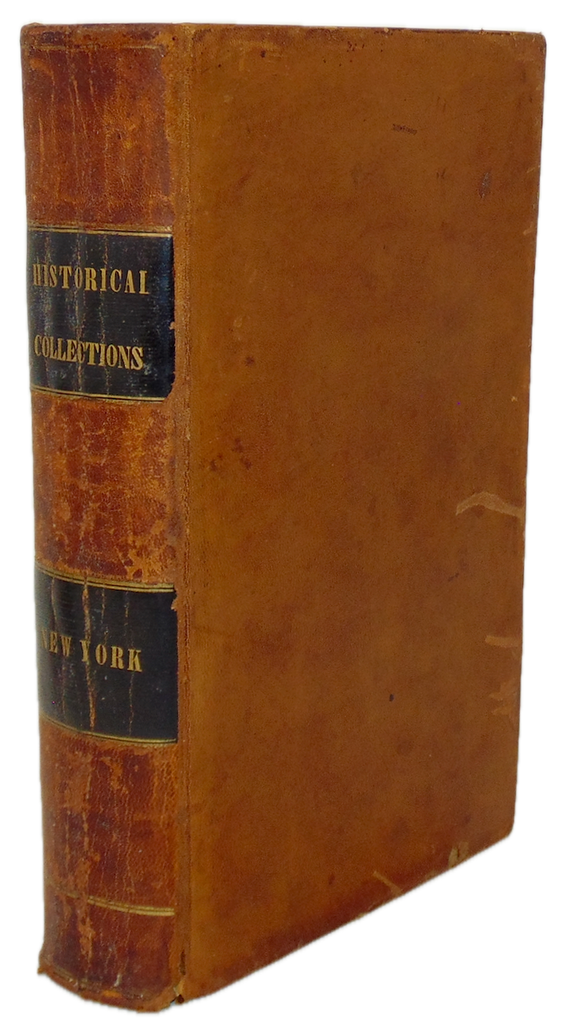
Barber, John W.; Howe, Henry. Historical Collections of the State of New York; containing A General Collection of the most Interesting Facts, Traditions, Biographical Sketches, Anecdotes, &c. relating to its History and Antiquities, with Geographical Descriptions of every Township in the State. Illustrated by 230 Engravings. New York: Published for the Authors, by S. Tuttle, 1841. First Edition. [11554]
Full original sheep with black leather spine title labels in bright gilt, some edge-wear yet with strong joints, 9 1/2 x 6 1/8 inches (binding), 9 1/4 x 5 3/4 inches (text block); page edges with light marbling. Steel-engraved frontispiece with tissue guard: the portraits of Peter Stuyvesant, George Clinton, Philip Schuyler, John Jay, and De Witt Clinton. Woodcut "Arms of the State of New York" as vignette on title page. Engraved folding map of New York State, 12 1/2 x 15 1/2 inches including margins; map with hand-colored outline of the state and leaf borders in yellow, counties outlined in red, short tear where attached and in two bottom folds. An additional 10 wood-engraved and 2 steel-engraved plates, over 200 woodcut illustrations; 608 pages; medium scattered foxing, toning, or light stains. Very good. Hardcover.
Howes B122: this is the true first edition.
Flake 299 for the Mormon content, "The founding of Mormonism in the History of Wayne Co., p. 396-98, Palmyra, p. 580-2." This includes "the earliest illustration ever done of the Hill Cumorah." - Rick Grunder.
Additional steel plates: S. E. View of Albany, from Greenbush Ferry; S. W. View of New York from Bedlow's I..
Additional wood plates: South Eastern View of Hudson City, N. Y., from Academy, on Prospect Hill; Western View of Poughkeepsie, N. Y.; North West View of Buffalo, N. Y.; North Western View of Brooklyn, N. Y., from near Peck Slip, New York City; Central Part of Buffalo Street, Rochester, N. Y.; Genesee and Washington Streets, Utica, N. Y.; Southern View of Oswego; Northern View of Troy, N. Y., from Mount Olympus; Eastern View of Schenectady, N. Y.; Eastern View of Ithaca, Tompkins Co., N. Y.
"The design of this volume is to give an account of the most important and interesting events relating to the state of New York, from its settlement to the present time, with geographical descriptions, illustrated by numerous engravings. In collecting the materials and preparing them for publication, the compilers of this work have unitedly spent more than two years of close and laborious application. We have visited every part of the state, and besides travelling thousands of miles on the public conveyances, he have journeyed many hundreds on foot...The numerous engravings interspersed throughout this volume, were, with few exceptions, copied from drawings taken on the spot by the compilers of the work. In these engravings, our principal object was to give faithful representations, rather that picturesque views, or beautiful specimens of art." - Preface.
John Warner Barber (1798-1883), b. East Windsor, CT; D. New Haven, CT. At death of his father when John was 14 years of age, he became the principal financial supporter of his mother and five siblings. John began to write and illustrate his own religious and historical books, and became a success. His Connecticut Historical Collections has been called "the first popular local history published in the United States," bibliola dot com.
Henry Howe (1816-1893), b. New Haven, CT; d. Columbus, OH. His father - Hezekiah Howe - owned a bookstore and was the first publisher of Noah Webster's American Dictionary of the English Language (1828). Young Henry grew up amidst books and the printing trade, contributing articles to the local press. In 1838 he was greatly impressed with John Warner Barber's book, Historical Collections of Connecticut, which Barber had compiled by traveling the state, collecting material and making sketches. Howe determined to make similar books, and compiled one on New York (1841), New Jersey (1842), and Virginia (1845). His three-volume Historical Collections of Ohio (1847) was immensely popular.
He moved to Cincinnati in 1848 and continued his historical writing, including The Great West, and books of travel and biography. His Times of Rebellion in the West, written just after the first American Civil War, also sold well. An historical marker placed by the Franklin County Historical Society at Howe's home in Columbus reads, "He preserved for posterity the story of the brave men and women who founded this great state." And so he also did with his other historical works.














